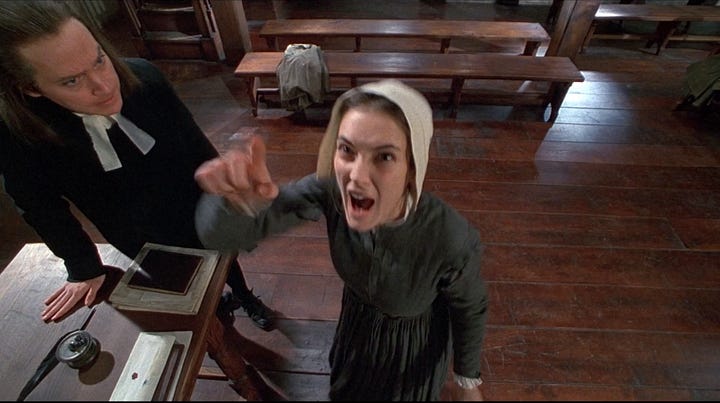Distorting for Terror: THE CRUCIBLE
This scene from 1996’s adaptation of The Crucible uses camera angles and movements, lenses, and what it doesn’t show, to make the viewer feel uneasy.
Angles
After a perfunctory ‘here’s where these characters are in relation to each other’ midshot, the scene moves into closeups.
The three closeups are at eye level, typical lensing, and all clean — in other words no drastic looking up or down, no distortion of their faces or the frame, and no other character or items between the characters and the camera.



The shots’ standard feel sets us up for the Abigail Williams (Winona Ryder) scream and jump scare moment.
The jump scare cuts from a closeup of Abigail into another closeup of Abigail; an atypical choice which works because the edit is going for a strange feeling.
Making the cut on her eye movement (0:07-0:08) motivates the switch.


Abigail’s scream is accompanied with a crane shot which starts as close to her as the other closeups but immediately pulls up-and-back to a high angle wide; though it moves quickly, our first impression is how very distorted her face is, a creation of the camera lens choice.
Lenses
Using a wide angle lens for closeups creates a bulbous look; often we talk about ‘fish-eye’ or ultra-wide lenses, but even standard wide lenses get closer to a fishbowl look the closer the camera gets to a subject.
The shot of Abigail is the most distorted when we’re closest to her; once the shot reaches its peak height and width it’s less distorted, but you can still see something ‘funhouse mirror’ about it. Look how foreshortened John Proctor (Daniel Day-Lewis) looks near the middle of frame, while at the bottom you can see Rev. Parris (Bruce Davison) has a bobblehead effect to him with the parts of his body we can see appearing teeny-tiny in relation to his head. (You can compare the straight lines of the pews and beams to the other wide shot near the bottom of this post.)
It holds here for a moment to see the characters move around the room and settle into new positions in relation to each other, Abigail running from the men and joining the group of women.
Angles (again)
After this crane movement and wider shot showing the entire room, the rest of the scene heavily favours closeups.
Even the medium shots are crowded with faces, which makes us feel uncomfortably close to the frenzied girls. The men’s shots are less crowded and less closeup, because the scene isn’t about them, they’re somewhat as lost as to whether or not the girls are seeing anything as we are.



And we don’t know because despite the furor being about the corner, the scene never gives us a shot of the corner, POV or otherwise.
What It Doesn’t Show
As the scene goes on it becomes quite clear the corner is intentionally avoided. Though the film’s opening scene is more explicit about what happened in the woods than the stageplay, this The Crucible adaptation makes a choice is to never show us the demons or sexual acts or terrors the townsfolk talk about, only ever give us testimony of those things even though film is a medium which could show these things far easier and more explicitly than a stageplay could.
Finally we get a shot from the POV of the corner; this is similar to the end of the crane shot, but not as distorted and bulbous.
It’s also still, as though to suggest something is there, impervious and unmoving.
Takeaways
One way to set the audience up for a dramatic shot is to give them a series of deliberately typical shots in the leadup; three closeup still typical shots lead into a moving wide-angle close-to-wide shot, and sudden change is jarring.
Making the change along with another cue or two — in this case Abigail’s eye shift and scream — is also effective.
Consider what you DON’T want to show; if you want to cast doubt on someone’s state of mind, what better way than to never confirm or deny what they’re saying they see, but to give a shot which suggests there could maaaaaaybe be something there.




